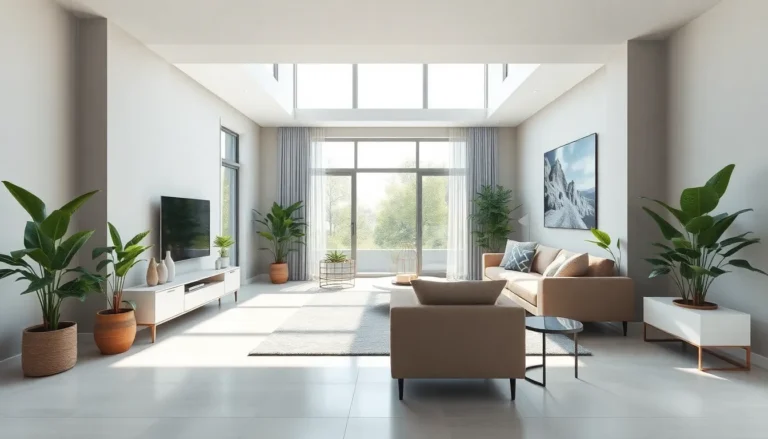Table of Contents
ToggleImagine walking into your home and having the lights turn on automatically, the thermostat adjust to your preferred temperature, and your favorite music start playing—all without lifting a finger. Sounds like something out of a sci-fi movie, right? Well, it’s not! With DIY home automation, turning your humble abode into a smart sanctuary is easier than you think.
What Is DIY Home Automation?
DIY home automation refers to the process of creating an automated home environment that enhances comfort, efficiency, and security. Homeowners can connect various devices to a central system to control lighting, heating, cooling, and entertainment systems remotely.
Many people opt for DIY home automation due to its cost-effectiveness and flexibility. Customizable solutions allow individuals to design a system that fits their preferences and needs. Using off-the-shelf products, such as smart bulbs and sensors, simplifies the setup process and reduces reliance on professional installers.
An array of devices can be integrated into a smart home system. Smart thermostats adjust temperature according to daily routines, while smart locks offer enhanced security. Home surveillance cameras provide peace of mind by allowing users to monitor their property in real time.
Automation systems often feature compatibility with voice assistants, enabling voice commands for hands-free control. Scheduling and remote access further increase convenience, allowing individuals to manage their home from anywhere via a smartphone app.
Popular platforms like Google Home and Amazon Alexa provide seamless integration for multiple smart devices. Each platform supports an extensive range of products, making it easier for homeowners to start small and expand their system over time.
Utilizing plugins and extensions can enhance the functionality of existing devices. Homeowners can automate tasks like turning off lights when no one is home or adjusting the thermostat based on weather forecasts. This ability to automate everyday tasks demonstrates how DIY home automation can improve life quality significantly.
Benefits of DIY Home Automation
DIY home automation offers several advantages that enhance the modern living experience.
Cost Savings
Cost savings represent one of the main benefits of DIY home automation. Homeowners gain financial advantages by avoiding professional installation costs. Budget-conscious individuals can purchase affordable off-the-shelf devices and set them up without help. Smart devices can also lead to reduced energy bills through efficient usage. Smart thermostats adjust heating and cooling automatically, optimizing energy consumption. Over time, these savings accumulate, making DIY solutions a smart long-term investment.
Customization Options
Customization options abound with DIY home automation projects. Homeowners can tailor the system to fit specific needs and preferences. Adding various devices allows for unique combinations of functionality, enhancing the setup. Different homeowners may prefer lighting schedules, temperature settings, or security features that reflect their lifestyles. This flexibility empowers them to select products, platforms, and configurations that meet their requirements. Exploring new technologies enables continuous innovation within the home environment.
Increased Control
Increased control is another significant benefit of DIY home automation. Homeowners gain the ability to manage their devices from anywhere using smartphone apps. Voice control through assistants like Amazon Alexa or Google Home further simplifies operations. Monitoring systems can provide real-time updates, allowing users to respond promptly to potential issues. Automating daily routines leads to a greater sense of security and convenience. With comprehensive control, home environments become more responsive to individual lifestyles.
Popular DIY Home Automation Devices
Numerous devices enhance a DIY home automation setup, achieving greater control, efficiency, and security.
Smart Lights
Smart lights transform any room into a customizable space. Users can select colors and brightness levels through smartphone apps or voice commands. Options include smart bulbs, strips, and fixtures compatible with existing light sockets. Energy efficiency is another advantage, as smart lights lower electricity bills by allowing users to schedule on-off times. Additionally, integration with sensors enables automatic adjustments based on room occupancy, ensuring lights remain off when not in use.
Smart Plugs
Smart plugs add automation capabilities to ordinary appliances. These devices plug into standard outlets and allow users to control connected items remotely. Programmable schedules permit appliances to turn on or off at specific times, promoting energy conservation. Compatibility with voice assistants allows for hands-free operation, enhancing convenience. Some smart plugs even offer energy monitoring features, providing insights into energy consumption patterns.
Security Cameras
Security cameras contribute significantly to home safety and peace of mind. Various models, including indoor and outdoor options, cater to different needs. Remote access enables users to monitor their properties from anywhere using mobile devices. Many cameras feature motion detection and alerts, ensuring immediate notifications for unusual activities. Cloud storage options allow for easy retrieval of recorded footage, enhancing overall security and surveillance capabilities.
Getting Started with DIY Home Automation
Starting a DIY home automation project requires thoughtful planning and consideration of personal needs. Homeowners assess their lifestyles and the specific improvements they want to make. Understanding the areas for improvement, like security or energy efficiency, helps prioritize the devices to integrate into the smart home system.
Assessing Your Needs
Identifying needs is the first step in creating a smart home. Begin by determining which areas in the home require automation. Consider factors, such as energy savings, security enhancements, or convenience. Homeowners might find that automating lighting helps reduce energy bills. Security needs such as smart locks or cameras can provide peace of mind. Establishing a list of priorities simplifies the selection process of devices later on.
Choosing the Right Devices
Selecting the right devices plays a crucial role in a successful DIY home automation project. Researching products that match specific needs ensures compatibility with existing systems. Popular options include smart thermostats, lighting systems, and surveillance cameras. Choose devices that work well with platforms like Google Home or Amazon Alexa for better integration. Adding devices that offer remote control via smartphone apps provides additional convenience. Reliable customer reviews can also guide decisions, helping homeowners invest wisely in their automation solutions.
Embracing DIY home automation opens up a world of possibilities for homeowners. It not only enhances comfort and security but also promotes energy efficiency and cost savings. By integrating smart devices into their living spaces, individuals can create a tailored environment that suits their unique lifestyles.
The journey into home automation doesn’t have to be overwhelming. With a plethora of accessible products and platforms available, anyone can start small and gradually expand their systems. As technology continues to evolve, the potential for creating a fully automated home becomes increasingly attainable. Homeowners can take pride in their ability to customize their spaces while enjoying the convenience that smart technology brings to everyday life.


